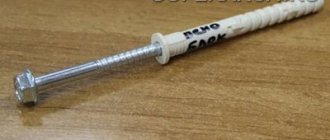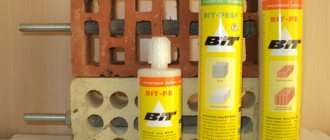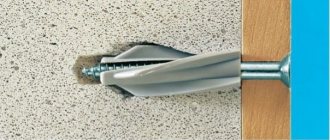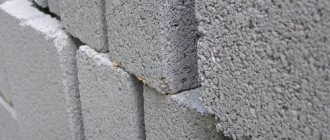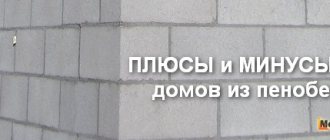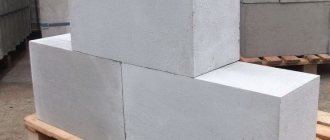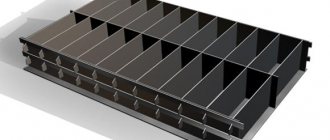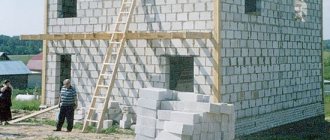Dismantling foam concrete fasteners
Fasteners for foam concrete are one of the “blank spots” in the construction world. Is it needed at all, or is it just another “duck” for the enrichment of third parties? Let’s philosophize on this topic, and also consider the main guidelines that will help you “not get lost” in a wide variety of similar hardware and make the right choice.
Characteristics
When choosing a dowel for a foam block, we pay attention to the following characteristics of this fastener.
- Length. This is especially important when installing on thin heat-insulating foam blocks, so that the dowel does not end up being longer than the width of the foam concrete block. Well, in other cases we select it according to the length of the fastening element.
- Diameter. In a bundle, the diameter of the fastener is important. We carefully select the drill so as not to drill a hole of a larger diameter!
- The size of the spacer. The strength of fixation of the entire structure largely depends on it.
- Permissible load that the dowel can withstand. No comments here, better with reserve.
- Resistance to moisture when installing external structures. The last item on the list, but don’t forget about it when doing exterior work. Important.
Only with a suitable choice can you guarantee the reliability of fastening, which has a direct impact on the durability of structures, the safety of operation of cabinets and shelves mounted on walls, air conditioners and boilers.
Classification of self-tapping screws for aerated concrete and foam concrete blocks
| Profile | Diameter, mm | Length, cm | Photo | A comment |
| Nog | 7,5 | 7 — 20 | Dowel with dowel for foam concrete | Can be used in aerated concrete blocks without dowels. In foam blocks only with dowels. |
| Universal | about 6 | until 22 |
| Average thread pitch. Can be mounted without dowels |
| Christmas tree (mef) | up to 8 | up to 20 | Christmas tree screw (mef) for foam concrete | Average thread pitch. Can only be used with mef dowels |
Dowels for self-tapping screws
Without dowels, self-tapping screws for aerated concrete are not often used due to the porous structure of the blocks. They are used for fastening lightweight structures. Thus, they can easily secure a reinforced mesh to an aerated concrete surface before applying plaster. For such fastening, self-tapping screws with a wide pitch and a length of at least 10 cm are selected.
In this case, it will not be possible to use a hammer drill, since the aerated concrete will crumble greatly. A drill with a thin drill bit is used. There is a way to screw self-tapping screws into a porous surface using machine oil. A few drops of oil are added to the prepared hole, so the hardware can be easily screwed in. The hardware will fit tightly, and it will be difficult to unscrew it in the future.
Self-tapping screws with a herringbone profile can be hammered into foam concrete blocks. The consumables along with the dowels are driven in “forever”; it is almost impossible to dismantle them. The work must be done quickly so that the prepared hole does not begin to crumble.
Types of fasteners
Regardless of what the foam block dowel is made of, they all work on the same principle. A screw-in self-tapping screw pushes the walls of the cage apart and wedges them into the hole. Due to the increased friction force, arbitrary removal of fasteners from foam concrete blocks under the weight of the fixed structure is impossible without additional effort.
Based on the installation principle, a dowel for a foam block, like any other, can be divided into two popular categories.
- Hammerable, designed for installation of light structures and parts.
- Screw-in, which can withstand heavy loads.
There is, however, one more category that is used less frequently. This is a chemical dowel for a foam block, with the fastening element installed using epoxy or other polymer glue. Yes, it is reliable, but much more expensive. Therefore, it is used selectively. This option is often used when installing powerful studs or screws designed to hold heavy structures. Then this applies more to anchors.
If we use a chemical dowel for a foam block, we take special care when working on finishing. This is due to the fact that during installation, part of the injection solution can often be squeezed out. And the coloring pigment contained in it can damage finishing materials.
Perhaps I recommend watching the following video here. Although it uses a gas block, all this also applies to a foam concrete block. In addition to generally good tests, towards the end an excellent alternative to the classic chemical dowel is shown.
For external work we use rust-resistant fasteners - metal, galvanized or anodized, as well as from various types of polymers.
To work with soft thermal insulating foam blocks, it is recommended to use screw-in types of dowels. They are designed to be installed with self-tapping screws or threaded screws. Installation is carried out with a drill or a powerful screwdriver. Due to the low density of the material, no difficulties arise during installation.
Below you can find out what a dowel for a foam block can be like.
Metal
It is a steel or brass hollow sleeve with longitudinal cuts. It can be either driven in or screwed in. Supplied complete with fasteners, but even with the same diameter it can be used for different types of self-tapping screws.
Therefore, please note that if dowels separately are much cheaper, you can buy them and assemble the kits yourself without overpaying for ready-made ones.
While metal dowels with a smooth outer surface are suitable for standard concrete, this option is not suitable for foam concrete blocks. The force generated during opening may not be sufficient to secure it in porous foam concrete. For foam blocks we use metal dowels only with a corrugated outer surface. In addition, you can bend 2-3 tabs on the outer rim; when installed, they will fit into the wall and prevent scrolling.
Basically, metal dowels for foam blocks are used for fastening elements of suspended load-bearing facade systems, internal cladding frames, furniture cabinets and other heavy objects. Products with a diameter of 10-12 mm are comparable in load-bearing capacity to metal anchors.
Plastic
It is the plastic dowel for foam blocks that is most often used. It also happens to be driven in or screwed in, which is less common, with an external thread. Diameter from 4-5 to 15-25 mm. Depending on their size, they are used for fastening both light and heavy objects and hanging structures.
In addition to standard ones, secret options are possible. They differ from each other by the presence of a “fungus” (supporting platform) in the upper part.
Interestingly, depending on the scope of application, they have different lengths of the split part (the larger this parameter, the more reliable the fastener).
For more reliable fixation, dowels with additional external tendrils are used to prevent spontaneous removal.
When choosing plastic products, you should take into account the fact that certain types of materials become brittle at low temperatures. As a result, they may break when twisted or hammered. Therefore, for outdoor work or installation in unheated rooms in winter, it is better to choose fasteners made from other materials, such as nylon.
Nylon
In appearance, it does not differ from plastic elements, is produced in the same standard sizes, and is used for fastening battens, light and medium-weight structures. Advantages: increased tensile strength, possibility of use at temperatures up to 40 degrees below zero.
Among other advantages of nylon dowels for foam blocks, we note:
- resistance to deformation when driving;
- reliable fixation under dynamic loads;
- inability to remove from the wall even with great effort;
- resistance to aggressive substances and corrosion.
Nylon dowels for foam blocks are used when installing critical structures. In terms of price, it is slightly more expensive than simple plastic ones, so this choice is quite advisable.
Dowel nail
The standard dowel nail is designed for through fastening of various materials to wall structures. It is distinguished by an increased diameter, which increases strength and resistance to deformation when driving. Installation using such nails is carried out manually or using pneumatic or electric guns (hammers).
For cellular concrete, due to its low strength, the use of standard fasteners of this class is almost impossible: they are simply pulled out of the wall. Therefore, for foam blocks we use a special dowel-nail of a composite structure, with an outer drop-down collar.
The installation principle is as follows:
- hammer into the wall in the standard way by hitting the head;
- To fix it in the wall, we finish off the central fastening rod to expand the outer frame.
Only in this case will the load-bearing capacity of the dowel nail be ensured.
Separately, it should be noted that the use of such fasteners in heat-insulating foam blocks of the D200-D300 brands is absolutely impractical. They do not guarantee long-term durability of the fixation.
Frame
Used for installing aluminum and plastic window and door blocks. Each element can withstand a load of 30-50 kg. No more is required to solve the problem, since the main fixation is provided by polyurethane foam.
The frame dowel for the foam block, of course, in its design is more related to anchors; it consists of a movable screwed part and a split outer sleeve.
Differences of this type of elements:
- when the screw is tightened, the upper and lower parts of the sleeve expand, which increases the reliability of fixation;
- the expansion of the petals is ensured by movement along the thread of the conical bushing;
- The fastener has a countersunk head for a Phillips screwdriver or screwdriver bit.
For the installation of heavy structures, more powerful frame fasteners with a bolt head are used.
Practice has shown that it is almost impossible to remove the frame dowel for the foam block after installation, so they should be installed with the utmost care and precision, otherwise the holes will have to be redrilled.
For thermal insulation
To install polystyrene foam or basalt wool during the installation of suspended ventilated facades and insulation, special umbrella dowels (fungi) are used. They are distinguished by an increased area of the upper support platform, which allows you to reliably press the heat-insulating material. An additional advantage of such fasteners is the absence of cold bridges, which prevents freezing of the insulation and the wall.
For foam blocks, such a dowel comes with an enlarged spacer part, which is due to the insufficient strength and density of the wall material. The total length should exceed the thickness of the insulation by 1.5-1.7 times: only in this case can reliable fixation be guaranteed.
For foam plastic, dowels with a plastic central rod are suitable; for heavy mineral wool, fasteners with a galvanized steel nail are used. If there is a risk of corrosion, the umbrella is closed with a stopper, which prevents moisture from penetrating the metal.
Conclusion
Foam block is already a fairly inexpensive material, and the fastenings for it, if we choose plastic, this is a serious savings - the price will be minimal.
A variety of fasteners will allow us to carry out all the work on installing the cladding, and what is more important, we will be able to safely install various equipment on foam block walls, shelves, heating devices, and air conditioners.
However, for each equipment it is necessary to choose an anchor designed specifically for a specific load, and this is the main feature of working with a foam block wall, regardless of whether the work is external or internal. And in the video presented in this article you will find additional information on this topic.
Famous manufacturers
The cost largely depends on the popularity of the manufacturer and its advertising costs. At the same time, in terms of strength indicators and load-bearing capacity, the products of Russian and foreign companies do not differ.
Among domestic manufacturers we highlight:
- , offering a large selection of fasteners and tools for construction work;
- RosDubel enterprise, specializing in dowels, anchors, and other types of elements for connecting various materials and structures.
Good options are offered by Polish companies, for example Koelner, Rawlplug, which produces plastic products, Modeco, which produces metal elements. The products of the Swiss brand Mungo also deserve attention. Manufacturers from France (SNR) and Finland (Sormat) are not far behind them.
When purchasing, pay attention to the amount of fasteners in the package. By purchasing such a product individually, you risk overpaying 1.5-2 times. Choose sets of 200-500 pieces: it will be cheaper.
Features of fastening heavy structures to foam blocks
If you need to securely fasten a heavy structure to foam concrete, you must approach the choice of fasteners as responsibly as possible. The best option is through-mounting using metal studs and bolted plates. But this option is not always possible. The second method is to use a chemical anchor for fastening together with a metal anchor bolt or pin more than 15 cm long. This technology will distribute the loads as evenly as possible and prevent internal destruction of the material.
Briefly about use
Installation rules depend on the type of dowels used. The main role is played by the installation method:
- The driven type is installed in pre-drilled holes, the diameter of which must exactly match the dimensions of the element. If there is an error of 1-3 mm, it will not be possible to fix the part in the wall with the required degree of reliability.
- Screw-in fasteners can be used without drilling holes in low-density insulating foam blocks. Metal dowels can be screwed into structural foam concrete of grades D400-D800 without any problems.
It is better to hammer the dowel into the foam block with a rubber hammer. Thus, we reduce the risk of damage to the foam concrete block.
Among the general recommendations we note:
- before installation, it is necessary to carry out markings in accordance with the features of the structure being fixed;
- After drilling, you should clean the holes with a brush or pneumatic tool, thereby increasing the reliability of installation.
In general, installing a dowel in a foam block is not difficult; even a beginner can handle this installation.
Base
How to install a fabric ceiling with your own hands, step-by-step installation instructions
Before considering fasteners, it is necessary to understand exactly what features light porous bases have.
They are widely used in construction, since gas and foam concrete, gas silicates, lightweight concrete, hollow bricks and blocks, compared to classical concrete and bricks, are much lighter, less susceptible to moisture, and at the same time have sufficient strength, are easy to cut and process.
The use of such materials reduces the complexity and cost of construction. The only drawback is that not every fastener is suitable for such foundations. Therefore, understanding the principle of fastening and knowledge of its application become quite significant for the comfortable use of materials.
Which is better
It is impossible to say unequivocally which is better. Because when choosing, you need to take into account the type of structures and the specifics of the tasks being solved. In general, we use frame dowels for windows and doors; plastic and nylon are suitable for lightweight structures; for heavy load-bearing facade systems we choose metal options.
Pay attention to the correspondence of the length of the dowel to the thickness of the walls and the materials being connected. If the size of the expanding part is not enough, then there can be no talk of any reliability of fastening. And one more thing to remember: always buy dowels with a 10% margin, as some of them will definitely be damaged during installation.
Plastic
Dowel for walls made of foam concrete.
Cheaper plastic dowels can also be used for fastening plumbing fixtures, gratings, pipelines, and consoles. This dowel is made of plastic, and the fastener itself is metal. To fasten objects to foam concrete, metric screws are used.
The dowel for foam blocks has a specific thread that allows it to be easily screwed into materials with a porous structure.
Important. A very convenient design feature for installation is that metric screws are often made in the form of an attachment for a screwdriver.
Frame
Frame dowel made of polyamide (nylon).
Frame plastic dowels are made of polyamide (nylon) and are used with special galvanized steel screws. They are used for fastening window and door frames, slats and bars, metal profiles to walls made of foam concrete, lightweight concrete and gas silicate.
The design consists of the following components:
- long non-spacer part;
- extended three-section spacer zone;
- retaining edge to prevent falling into the hole.
There is a through hole in the very tail part of such a dowel; it provides the screw with optimal movement. It is the double spacer zone that allows you to securely fasten the mounted parts in materials with voids.
Such fasteners are difficult to replace and you should not try to save money by using simple dowels for bricks and foam blocks. It is clear that the price of special fasteners is somewhat higher, but the reliability of the fastening also complies with the standards.
Description of the dowel
Elements consisting of several parts are used as fasteners for foam blocks:
- threaded rod;
- plastic gasket;
- PVC half rings;
- bushing with spring segments.
The anchor has a countersunk head and four fastening elements to the foam block. Another important detail is the collar, which preserves the edges of the drilled hole.
The pointed spikes on the outside enhance the fixing ability and protect the fasteners for the foam block from turning while screwing into the thread. The classic dowel length is 25-55 mm, outer size 6-12 mm.
They are produced mainly in packaged form, 30-450 pieces, but they also come in bulk. Chemical anchors are sold in two-component tubes of various capacities.
Rod parameters for foam concrete
How to use?
It is easy to fix the fasteners in the wall if you have a drill, hammer and screwdriver at hand.
Before starting work, ensure that all necessary tools and materials are available. You will need a drill, a Phillips screwdriver, a hammer and a pencil with a ruler for marking. The work is performed in the following sequence:
- Preparing the hole. In order for the structure to hold better, it is recommended to drill a hole 2 mm less wide than the diameter of the fastener and longer so that the tip of the screw extends beyond the dowel. To do this, use an electric drill.
- Installation of dowels in aerated concrete. The plastic product is screwed into the wall with a screwdriver, and the metal version is hammered in with a hammer. Before this, the working area is cleared of concrete dust. Plastic products are easily screwed in thanks to their screw shape.
- Screwing in the screw. This stage is best carried out with a screwdriver, since a screwdriver can screw the screw too deeply or spin the fastener around its axis.
With the help of such fasteners, you can easily fix any type of structure on a wall made of aerated concrete. At all stages of installation, the integrity of aerated concrete is checked. The length of the hole is made with a margin of 10 mm for accumulating dust, which is additionally formed when installing the dowel directly into the gas or foam block. If strong fixation is required, it is better to choose chemical anchors or carry out additional reinforcement with construction foam.
The mounting anchor and installation method will depend on the future load
- when installing suspended shelves in aerated concrete, you must make a hole at an angle of 90 degrees and insert a dowel into which a screw is then screwed;
- If the task is to hang a light picture or install an electrical switch, it will be enough to use an ordinary self-tapping screw. Screwing should be done at an angle of 45 degrees to the partition.
Mechanical anchor
Mechanical anchors for aerated concrete blocks are called “butterflies”, this is explained by the peculiarity of their design. The edges of the fasteners that will be mounted in the holes are split into pieces when the anchor screw is screwed in; as a result, the anchor takes on the shape of a butterfly. With this method, a good fixation is obtained in a pre-drilled hole.
Bolts or threaded rods that are screwed into the spacer part of the anchor can widen the hole in the aerated concrete. To prevent this, an anchor fastener is used, which operates according to a mechanical feature and has an edge that prevents further advancement of the threaded part. Mechanical butterflies are popular for securely fastening objects to walls built from aerated blocks and other building materials with a cellular texture.
Chemical anchor
When it is necessary to fix a heavy element on an aerated concrete surface, chemical anchor bolts are used. The principle of operation of such an adhesive anchor is similar to the principle of a mechanical anchor bolt, the only difference is in the use of glue during installation. This technique allows for highly reliable fixation in porous structures - foam concrete slabs, gas silicate partitions, porous bricks.
